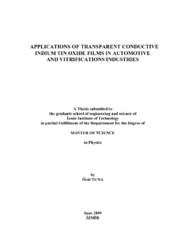Please use this identifier to cite or link to this item:
https://hdl.handle.net/11147/4065Full metadata record
| DC Field | Value | Language |
|---|---|---|
| dc.contributor.advisor | Selamet, Yusuf | - |
| dc.contributor.author | Tuna, Öcal | - |
| dc.date.accessioned | 2014-07-22T13:53:06Z | - |
| dc.date.available | 2014-07-22T13:53:06Z | - |
| dc.date.issued | 2009 | - |
| dc.identifier.uri | http://hdl.handle.net/11147/4065 | - |
| dc.description | Thesis (Master)--Izmir Institute of Technology, Physics, Izmir, 2009 | en_US |
| dc.description | Includes bibliographical references (leaves: 76-79) | en_US |
| dc.description | Text in English; Abstract:Turkish and English | en_US |
| dc.description | xii, 79 leaves | en_US |
| dc.description.abstract | Due to its unique electrical and optical properties, highly doped n-type Indium tin oxide used for various applications such as smart glass, LCDs, OLEDs, solar cells and car windows. In this study Indium Tin Oxide (ITO) thin films were grown by both DC and RF magnetron sputtering techniques. To know deposition rate of ITO, system was calibrated for both DCMS and RFMS and then ITO were grown on glass substrate with the thickness of 70 nm and 40 nm by changing substrate temperature. The effect of substrate temperature, film thickness and sputtering method on structural, electrical and optical properties were investigated. Wan der Pauw method was used for electrical characterization and to use this method properly, we patterned ITO thin films by photolithography and Ion beam etching techniques. The results show that substrate temperature and film thickness substantially affects the film properties, especially crystallization and resistivity. The thin films grown at the lower than 150 oC showed amorphous structure. However, crystallization was detected with the further increase of substrate temperature. Substrate temperature and film thickness increment were lead to increase band gap of ITO which can be explained by BMS. Band gap of ITO was calculated to be about 3.64 eV at the substrate temperature of 150 oC, and it widened with substrate temperature increment. From electrical measurements the resistivity at room temperature was obtained 1.28*10 and 1.29*10 cm, for DC and RF sputtered films, respectively. We also measured temperature dependence resistivity and the Hall coefficient of the films, and we calculated carrier concentration and Hall mobility. | en_US |
| dc.language.iso | en | en_US |
| dc.publisher | Izmir Institute of Technology | en_US |
| dc.rights | info:eu-repo/semantics/openAccess | en_US |
| dc.subject.lcc | QC611.8.M4 .T92 2009 | en |
| dc.subject.lcsh | Metal oxide semiconductors | en |
| dc.subject.lcsh | Indium | en |
| dc.subject.lcsh | Thin films | en |
| dc.subject.lcsh | Tin alloys | en |
| dc.title | Applications of Transparent Conductive Indium Tin Oxide Films in Automotive and Vitrifications Industries | en_US |
| dc.type | Master Thesis | en_US |
| dc.institutionauthor | Tuna, Öcal | - |
| dc.department | Thesis (Master)--İzmir Institute of Technology, Physics | en_US |
| dc.relation.publicationcategory | Tez | en_US |
| dc.identifier.wosquality | N/A | - |
| dc.identifier.scopusquality | N/A | - |
| item.cerifentitytype | Publications | - |
| item.openairecristype | http://purl.org/coar/resource_type/c_18cf | - |
| item.languageiso639-1 | en | - |
| item.openairetype | Master Thesis | - |
| item.fulltext | With Fulltext | - |
| item.grantfulltext | open | - |
| Appears in Collections: | Master Degree / Yüksek Lisans Tezleri | |
Files in This Item:
| File | Description | Size | Format | |
|---|---|---|---|---|
| T000821.pdf | MasterThesis | 51.93 MB | Adobe PDF |  View/Open |
CORE Recommender
Page view(s)
260
checked on May 12, 2025
Download(s)
92
checked on May 12, 2025
Google ScholarTM
Check
Items in GCRIS Repository are protected by copyright, with all rights reserved, unless otherwise indicated.